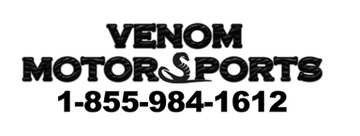How to use the choke on your bike (50cc-250cc) - x19, x18, Scorpion 125cc atv
How DOES MY CHOKE WORK?
Welcome to this week’s tech talk at Venom Motor Sports!
We get a lot of people asking about the operation of the “choke” on their bikes.
Listed below are answers to some of the more common “choke” related questions I am asked by our customers.
Keep in mind that this information applies to all of our fine gas powered Super Pocket Bikes, Dirt Bikes and ATVs!
Ok onto this week’s topic.
So Tim...how does a “choke” work?
Well you take your two hands and firmly grasp your opponent’s throat just below the Adams apple...opps sorry wrong choke discussion.
Let’s try again...the purpose of the “choke” is to enrich the air fuel mixture to help start a cold engine. Cold is the key word here because a “cold engine” will not easily vaporize the fuel in the air fuel mixture entering the engine. So we need to enrich the mixture in a cold engine to increase the amount of combustible vapour present.
When you close the “choke” you reduce the volume of combustion air entering the cylinder, this changes the air/fuel ratio to a very rich mixture. More fuel in the air fuel mixture than normal helps the bike to achieve ignition of the air fuel mixture and start.
Tim...do I need to use the choke every time I start the bike?
This is a great question again the key word is “cold”.
If the bike is cold than yes! Close the choke fully before trying to start it, and do not touch the throttle. Once the bike starts and warms for a minute you can open the choke and drive away. This is a good practise as all bikes need to sit for that first minute of operation to allow for lubricating oil to work its way through the engine. Just giving your bike a minute to warm up will extend the life of the engine. I know its tuff to do because we all want to just take right off...but it’s a good habit to form.
Ok so if the bike has been sitting in the sun all day...do I still need to “choke” it to get it started? No choke is needed. If the engine is warm, the engine will start right up.
What if I was riding the bike, than stopped for awhile? Do I need to “choke” it again to get it started? Again No... If the engine is warm, the engine will start right up.
Ok Tim so how warm is warm enough? Think about a cup of coffee in your hands, yeah about that warm is warm enough to not require any “choke”.
Tim...how do I know if the “choke” is open or closed?
If you are not sure if the “choke” lever is in the open or closed position you can figure this out easily.
Simply remove the air filter fitted to the carburetor and look into the throat of the carb.
Move the “choke” lever back and forth.
When the “choke” is closed you will see a metal plate restrict the opening of the carb throat.
When the “choke” is open you will not see the metal plate and you can see right into the throat of the carb.
Tim...what happens if I drive the bike with the “choke” closed?
Well this is something we have all done at some point.
As the engine is running very rich it will tend to “bog” down when you hit the throttle.
So when you give the engine throttle to speed up...it will do so very slowly, seem to have no power or simply stall out as the air/fuel mixture is too rich.
No need to worry, once you open the “choke” up your bike once again runs just fine.
Flooding the engine happens when you “choke” an engine that does not need to be “choked”. With the “choke” closed we roll the engine over again and again and again without achieving ignition of the too rich air fuel mixture. This floods the cylinder with a super rich air fuel which will not ignite or support combustion as there is too little air in the air/fuel mixture. No need to worry, just open the “choke” and try to start the engine again.
I hope you enjoyed this week’s tech talk, please take a moment and check out our “choke” video on youtube!
Click on the link below.
If you have any tech questions about our bikes, please feel free to email them to...
Support@venommotorsportscanada.com
Have a great day!
Tim
Technical Support Specialist
Venom Motor Sports






